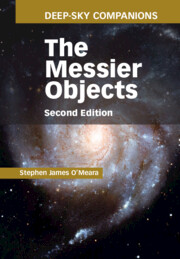Book contents
- Frontmatter
- Contents
- Preface to the second edition
- Preface to the first edition
- Acknowledgments to the first edition
- Chapter 1 A glimpse into the life of Charles Messier
- Chapter 2 How to observe the Messier objects
- Chapter 3 The making of this book
- Chapter 4 The Messier objects
- Chapter 5 Some thoughts on Charles Messier
- Chapter 6 Twenty spectacular non-Messier objects
- Appendix A Objects Messier could not find
- Appendix B Why didn’t Messier include the Double Cluster in his catalogue?
- Appendix C A quick guide to navigating the Coma–Virgo Cluster
- Appendix D Messier marathons
- Image credits
- Alternate name and object index
Preface to the first edition
Published online by Cambridge University Press: 18 December 2014
- Frontmatter
- Contents
- Preface to the second edition
- Preface to the first edition
- Acknowledgments to the first edition
- Chapter 1 A glimpse into the life of Charles Messier
- Chapter 2 How to observe the Messier objects
- Chapter 3 The making of this book
- Chapter 4 The Messier objects
- Chapter 5 Some thoughts on Charles Messier
- Chapter 6 Twenty spectacular non-Messier objects
- Appendix A Objects Messier could not find
- Appendix B Why didn’t Messier include the Double Cluster in his catalogue?
- Appendix C A quick guide to navigating the Coma–Virgo Cluster
- Appendix D Messier marathons
- Image credits
- Alternate name and object index
Summary
Two and a half centuries ago a French comet hunter named Charles Messier began compiling a catalogue of nebulous sky objects. He explained his motivation in the French almanac Connaissance des Temps for 1801:
What caused me to undertake the catalogue was the nebula I discovered above the southern horn of Taurus on 12 Sept. 1758, while observing the comet of that year.… This nebula had such a resemblance to a comet, in its form and brightness, that I endeavored to find others, so that astronomers would not confuse these same nebulae with comets just beginning to shine.
Messier died long before twentieth-century astronomers realized the profound nature of these hauntingly diffuse glows. The 110 “Messier objects,” it turns out, are an eclectic collection of celestial treasures: 39 galaxies, 57 star clusters, 9 nebulae, a supernova remnant, a swath of Milky Way, a tiny grouping of stars, a double star, and even a duplication. The list includes the most massive and luminous galaxy known, the ghostly remains of a cataclysmic stellar explosion, and an immense cosmic cloudscape that cradles newborn stars in dense cocoons of hydrogen gas.
Every Messier object is within reach of a small telescope, and many are visible with binoculars and the naked eye, especially under clear, dark skies far away from city lights. Amateur astronomers of all ages enjoy tackling the Messier catalogue members, because they represent a good sampling of what’s “out there,” and because finding them helps to hone observing skills. In a sense, the Messier objects are the testing grounds for budding skywatchers.
- Type
- Chapter
- Information
- Deep-Sky Companions: The Messier Objects , pp. ix - xiiPublisher: Cambridge University PressPrint publication year: 2014

